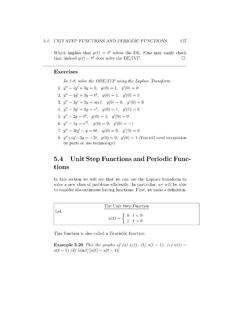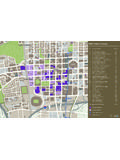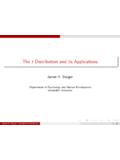Transcription of Net Change and Displacement - HWS Department of ...
1 Math 131,applicationsmotion:velocity and net Change 1 Net Change and DisplacementWe have seen that the definite integral baf(x)dxmeasures thenet areaunderthe curvey=f(x)on the interval[a,b]. Any part of the region below thex-axiscontributes negatively-signed area to this net calculation. To find thetotal areaenclosed byfon[a,b], one needs to evaluate the definite integral of the absolutevalue off(x): ba|f(x)|dxWe can apply this idea to other contexts. In Calculus I we interpreted the firstand second derivatives as velocity and acceleration in the context of motion. Inparticular, l s(t) =position at timet. s (t) =v(t) =velocity at timet. s (t) =v (t) =a(t) =acceleration at our point of view and using antiderivatives, since positions(t)is anantiderivative of velocttyv(t), by the FTC (II) we have bav(t)dt=s(t) ba=s(b) s(a).Buts(b) s(a)represents thenet distance traveledordisplacementof the object dur-ing the time interval because it is the difference in locations at the end and start ofthe time we wanted thetotal distance traveledrather than the net distance traveled, justas with the area problem, we would compute the integral of|v(t)|instead.
2 That is,total distance traveled= ba|v(t)| can be summarized as ( Displacement versus Distance).Assume that thepositionof an object mov-ing along a straight line at timetis denoted bys(t)relative to the origing and that itsve-locityis denoted byv(t). net Change in position of the object between timest=aandt=b>ais given bys(b) s(a) = bav(t) distance traveledby the object between timest=aandt=b>ais givenby ba|v(t)| an object moves with velocityv(t) =2t2 12t+16 km/hr along astraight road.(1) Determine the Displacement of the object on the time interval[1, 3]and[0, 4]andinterpret your answer.(2) Determine the distance travelled on the time interval[0, 4]. : Mitchell-2015/09 :32:25math 131,applicationsmotion:velocity and net Change 2(1) The Displacement is easy to calculate: For the interval[0, 4], On[0, 4], Displacement on[0, 4] =s(4) s(0) = 402t2 12t+16dt=2t33 6t2+16t 40=1283 96+64 0= [1, 3],s(3) s(1) = 312t2 12t+16dt=2t33 6t2+16t 41= (18 54+48) (23 6+16)=43.
3 (2) The distance travelled is harder to determine since we need to integrate|v(t)|. We must first determine wherev(t)is positive and 12t+16+ + + ++002t2 12t+16=2(t2 6t+8) =2(t 2)(t 4) =0 t=2 ort= number line to the right shows that 2t2 12t+16 0 only[2, 4]. We cannow find the distance travelled (total area) by splitting the interval into twopieces[0, 2]and[2, 4], changing the sign ofv(t)on the second piece to obtainthe absolute value ofv(t).Dist Trav=Total Area= 40|2t2 12t+16|dt= 202t2 12t+16dt 422t2 12t+16dt=[2t33 6t2+16t] 20 [2t33 6t2+16t] 42=403+83= : The distance travelled on[0, 4]is the area under the absolutevalue of the velocity an object moves with velocityt3 5t2+4tm/s.(1) Determine the Displacement of the object on the time interval[0, 6]and interpret youranswer.(2) Determine the distance travelled on[0, 6]Solution.(1) For Displacement on[0, 6],s(6) s(0) = 60t3 5t2+4t dt=t44 5t33+2t2 60= (324 360+72) 0=36.
4 (2) For the distance travelled we must first determine wherev(t)is positive 146t3 5t2+4t+ ++0 00t3 5t2+4t=t(t2 5t+4) =t(t 1)(t 4) =0 t=0, 1, number line to the right shows thatt3 5t2+4t 0 only[1, 4]. We cannow find the distance travelled (total area) by splitting the interval into threepieces[0, 1],[1, 4]and[4, 6], changing the sign ofv(t)on the second piece : Mitchell-2015/09 :32:25math 131,applicationsmotion:velocity and net Change 3obtain the absolute value ofv(t).Dist Trav= 60|2t2 12t+16|dt= 10t3 5t2+4t dt 41t3 5t2+4t dt+ 64t3 5t2+4t dt=[t44 5t33+2t2] 10 [t44 5t33+2t2] 41+[t44 5t33+2t2] 64=712+454+1403= 2 3 4 5 6 PositionsSuppose that we know the velocity of an object moving along a straight line isv(x)and we know its positions(a)at some timet=a. [Note: Often we know theinitialposition s(0).] We can determine the future position at a time general timetusingthe Displacement equation. Sinces(x)is an antiderivative ofv(x), again FTC (II)tells us that tav(x)dx=s(x) ta=s(t) s(a).
5 Solving for the positions(t), we (Position from Velocity).Position at timet=s(t) =s(a) + tav(x) a similar way, ifa(t)represents acceleration of the object,velocity at timet=v(t) =v(a) + taa(x) that the acceleration of an object is given bya(x) =2 cosxforx 0 with v(0) =1 s(0) = (t). findv(t)using (t) =v(0) + t0a(x)dx=1+ t02 cosx dt=1+ [2x sinx] t0=1+ (2t sint) (0) =1+2t solve fors(t)by using (t) =s(0) + t0v(x)dx=3+ t01+2x sinx dx=3+ (x+x2+cosx) t0=3+ (t+t2+cost) (0+0+1) =2+2t+t2+ acceleration is given bya(t) =10+3t 3t2, find the exact positionfunction, ifs(0) =1 ands(2) = time we don t have a velocity at time 0. So letv(0) =v0be someunknown constant. We will see if we can work it out later. Thenv(t) =v(0) = t0a(x)dx=v0+ t010+3x 3x2dx=v0+10x+32x2 x3 t0=v0+10t+32t2 : Mitchell-2015/09 :32:25math 131,applicationsmotion:velocity and net Change 4 Nows(t) =s(0) + t0v(x)dx=1+ t0v0+10x+32x2 x3+c dx=1+ (v0x+5x2+12x3 14x4) t0=1+v0t+5t2+12t3 (t) =1+v0t+5t2+12t3 14t4.
6 To solve forv0, evaluate ats(t)att= (2) =1+2v0+20+4 4=11 so 2v0= 10 v0= ,s(t) =1 5t+5t2+12t3 Acceleration: GravityIn many motion problems the acceleration is constant. This happens when anobject is thrown or dropped and the only acceleration is due to gravity. In such asituation we have a(t) =a, constant acceleration with initial velocityv(0) =v0 and initial positions(0) = using (t) =v(0) + t0a(x)dx=v0+ t0a ds=v0+ax t0=v0+ (at 0) =at+ (t) =at+ ,s(t) =s(0) + t0v(x)dx=s0+ t0as+v0ds=s0+ (12ax2+v0x) t0=s0+ (12at2+v0t 0) =12at2+v0t+ (t) =12at2+v0t+ a ball is thrown with initial velocity 96 ft/s from a roof top432feethigh. The acceleration due to gravity is constanta(t) = 32 ft/s2. Findv(t)ands(t). Thenfind the maximum height of the ball and the time when the ball hits the thatv0=96 ands0=432 and that the acceleration isconstant, we may use the general formulas we just (t) =at+v0= 32t+96ands(t) =12at2+v0t+s0= 16t2+96t+ max height occurs when the velocity is 0 (when the ball stops rising):v(t) = 32t+96=0 t=3 s(3) = 144+288+432=576 ball hits the ground whens(t) = (t) = 16t2+96t+432= 16(t2 6t 27) = 16(t 9)(t+3) = only (sincet= 3 does not make sense).
7 : Mitchell-2015/09 :32:25math 131,applicationsmotion:velocity and net Change person drops a stone from a bridge. What is the height (in feet) of thebridge if the person hears the splash5seconds after dropping it? s what we (dropped) ands(5) =0 (hits water). Andwe know acceleration is constant,a= 32 ft/s2. We want to find the height of thebridge, which is justs0. Use our constant acceleration motion formulas to solve (t) =at+v0= 32tands(t) =12at2+v0t+s0= 16t2+ we use the position we know:s(5) = (5) = 16(5)2+s0 s0=400 that we did not need to use the velocity TRY (Extra Credit).In the previous problem we did not take into account thatsound does not travel instantaneously in your calculation above. Assume that sound trav-Check on your answer: Should thebridge be higher or lower than in thepreceding example? Why?els at1120ft/s. What is the height (in feet) of the bridge if the person hears the splash5seconds after dropping it?
8 S a variation. This time we will use metric units. Suppose a ball isthrown with unknown initial velocityv0m/s from a roof top49meters high and the po-sition of the ball at timet=3 iss(3) =0. The acceleration due to gravity is constanta(t) = m/s2. Findv(t)ands(t). timev0is unknown buts0=49 ands(3) =0. Again the accelera-tion is constant so we may use the general formulas for this (t) =at+v0= +v0ands(t) =12at2+v0t+s0= +v0t+ we know thats(3) = (3)2+v0 3+49=0which means3v0= (9) (10) = v0= (t) = 4930ands(t) = 4930t+ on Net Change and Future ValuesWe ve interpreted net area as Displacement and total area as total distance whenworking with a velocity function. But we can apply these same ideasanytimewehave a rate of Change function. Examples include whenf(t)is a flow rate of liquid(in which case we can compute net Change in volume), orf(t)is a populationgrowth rate (in which case we can compute future population estimates), orp(t) : Mitchell-2015/09 :32:25math 131,applicationsmotion:velocity and net Change 6the growth of a financial account (in which case we might compute the net changein value of the account).
9 In general, suppose we know the rate of Change in some quantity is given byQ (x)on the interval[0,t]. Then by integrating using FTC II and the fact thatQ(x)is an antiderivative ofQ (x), we get t0Q (x)dx=Q(x) t0=Q(t) Q(0).Again, as in , we can rearrange terms to (Net Change and Future Value).Assume that a quantityQchanges over timeat a know rateQ . Then thenet changeinQbetweent=aandt=b>aisQ(b) Q(a) = baQ (t) , ifQ(0)is the initial value, then thefuture valueofQat timet 0 isQ(t) =Q(0) + t0Q (x) (Population Growth).Suppose a rafter of wild turkeys in Geneva has an initialA group of turkeys is called a rafter. Agroup of turtledoves is called a ofP(0) =23 and the community grows at a rate ofP (t) =20 3 t, where time ismeasured in years. Determine the population in4years. Then find the general formula forthe population,P(t). the second part of ,P(4) =P(0) + 40P (t)dt=23+ 6015 t dt=23+(20t 6t3/23) 40=23+ (80 16) (0) = generally, the population at timetisP(t) =P(0) + t0P (x)dx=23+ t015 x dx=23+(20x 6x3/23) t0=23+20t 6t3 (Savings).
10 Grandparents of a newborn deposit $10,000in a college savingsaccount that has a growth rate of How much will be available in the accountwhen the child is18and starting college? the second part of ,Q(18) =Q(0) + 180Q (t)dt=10, 000+ , 000+ 180=10, 000+10, 180=10, 000+ (10, 10, 000) =27, bad, but not worth a semester at : Mitchell-2015/09 :32:25math 131,applicationsmotion:velocity and net Change (Economics).Themarginal costof a product is additional the cost incurredby producing one more item of the product. Typically, as production increases, the marginalcost decreases, at least up to a point. This is what people mean by the term "economy ofscale." Marginal cost is approximated by the derivative of the cost functionC (x)that de-pends on the number of unitsxbeing that the marginal cost is given by the functionC (x) =200+10x Findthe additional cost incurred when production rises from500to550units. Then find the costincurred when production rises the first part of ,C(550) C(500) = 550500C (x)dx= 550500300+10x +5x2 550500=(300(550) +5(550)2 (550)33) (300(500) +5(500)2 (500)33)=139, the second partC(600) C(550) = 600550C (x)dx= 600550300+10x +5x2 600550=(300(600) +5(600)2 (600)33) (300(550) +5(550)2 (550)33)=137, that the cost making50more units has decreased, illustrating the idea thatmarginal cost decreases as production : Mitchell-2015/09 :32:25math 131,applicationsmotion:velocity and net Change 8 For Fun: Additional Motion Problems with Constant AccelerationThe following problems all involve motion with constant acceleration.










